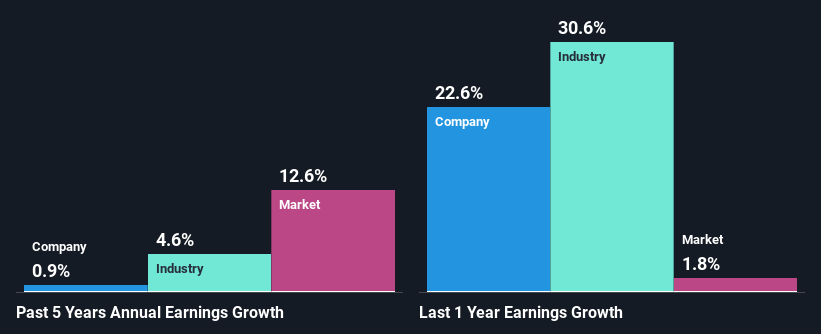Syarikat Takaful Malaysia Keluarga Berhad (KLSE:TAKAFUL) On An Uptrend: Could Fundamentals Be Driving The Stock?
Most readers would already know that Syarikat Takaful Malaysia Keluarga Berhad's (KLSE:TAKAFUL) stock increased by 4.5% over the past month. We wonder if and what role the company's financials play in that price change as a company's long-term fundamentals usually dictate market outcomes. In this article, we decided to focus on Syarikat Takaful Malaysia Keluarga Berhad's ROE.
Return on Equity or ROE is a test of how effectively a company is growing its value and managing investors’ money. In other words, it is a profitability ratio which measures the rate of return on the capital provided by the company's shareholders.
Check out our latest analysis for Syarikat Takaful Malaysia Keluarga Berhad
How Do You Calculate Return On Equity?
The formula for return on equity is:
Return on Equity = Net Profit (from continuing operations) ÷ Shareholders' Equity
So, based on the above formula, the ROE for Syarikat Takaful Malaysia Keluarga Berhad is:
20% = RM347m ÷ RM1.7b (Based on the trailing twelve months to December 2023).
The 'return' is the amount earned after tax over the last twelve months. That means that for every MYR1 worth of shareholders' equity, the company generated MYR0.20 in profit.
What Has ROE Got To Do With Earnings Growth?
Thus far, we have learned that ROE measures how efficiently a company is generating its profits. Depending on how much of these profits the company reinvests or "retains", and how effectively it does so, we are then able to assess a company’s earnings growth potential. Assuming everything else remains unchanged, the higher the ROE and profit retention, the higher the growth rate of a company compared to companies that don't necessarily bear these characteristics.
Syarikat Takaful Malaysia Keluarga Berhad's Earnings Growth And 20% ROE
To start with, Syarikat Takaful Malaysia Keluarga Berhad's ROE looks acceptable. On comparing with the average industry ROE of 14% the company's ROE looks pretty remarkable. However, we are curious as to how the high returns still resulted in flat growth for Syarikat Takaful Malaysia Keluarga Berhad in the past five years. Based on this, we feel that there might be other reasons which haven't been discussed so far in this article that could be hampering the company's growth. These include low earnings retention or poor allocation of capital.
Next, on comparing with the industry net income growth, we found that Syarikat Takaful Malaysia Keluarga Berhad's reported growth was lower than the industry growth of 4.6% over the last few years, which is not something we like to see.
Earnings growth is an important metric to consider when valuing a stock. What investors need to determine next is if the expected earnings growth, or the lack of it, is already built into the share price. This then helps them determine if the stock is placed for a bright or bleak future. One good indicator of expected earnings growth is the P/E ratio which determines the price the market is willing to pay for a stock based on its earnings prospects. So, you may want to check if Syarikat Takaful Malaysia Keluarga Berhad is trading on a high P/E or a low P/E, relative to its industry.
Is Syarikat Takaful Malaysia Keluarga Berhad Using Its Retained Earnings Effectively?
Despite having a normal three-year median payout ratio of 30% (implying that the company keeps 70% of its income) over the last three years, Syarikat Takaful Malaysia Keluarga Berhad has seen a negligible amount of growth in earnings as we saw above. Therefore, there might be some other reasons to explain the lack in that respect. For example, the business could be in decline.
Additionally, Syarikat Takaful Malaysia Keluarga Berhad has paid dividends over a period of at least ten years, which means that the company's management is determined to pay dividends even if it means little to no earnings growth. Based on the latest analysts' estimates, we found that the company's future payout ratio over the next three years is expected to hold steady at 33%. Therefore, the company's future ROE is also not expected to change by much with analysts predicting an ROE of 19%.
Summary
Overall, we feel that Syarikat Takaful Malaysia Keluarga Berhad certainly does have some positive factors to consider. Although, we are disappointed to see a lack of growth in earnings even in spite of a high ROE and and a high reinvestment rate. We believe that there might be some outside factors that could be having a negative impact on the business. That being so, the latest analyst forecasts show that the company will continue to see an expansion in its earnings. To know more about the latest analysts predictions for the company, check out this visualization of analyst forecasts for the company.
Have feedback on this article? Concerned about the content? Get in touch with us directly. Alternatively, email editorial-team (at) simplywallst.com.
This article by Simply Wall St is general in nature. We provide commentary based on historical data and analyst forecasts only using an unbiased methodology and our articles are not intended to be financial advice. It does not constitute a recommendation to buy or sell any stock, and does not take account of your objectives, or your financial situation. We aim to bring you long-term focused analysis driven by fundamental data. Note that our analysis may not factor in the latest price-sensitive company announcements or qualitative material. Simply Wall St has no position in any stocks mentioned.

 Yahoo Finance
Yahoo Finance 
